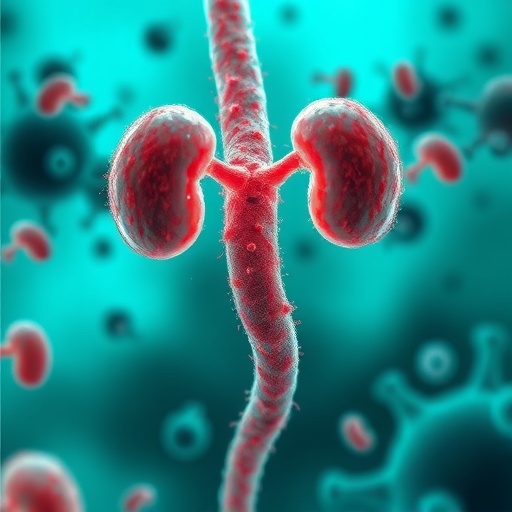In a groundbreaking study poised to revolutionize urological healthcare, researchers have unveiled a novel approach to combatting catheter encrustation by leveraging microbial-derived metabolites naturally present in the urinary tract. Catheter-associated infections and subsequent encrustations represent a persistent clinical challenge, often leading to severe complications including urinary tract infections (UTIs), device obstruction, and significant patient morbidity. Traditional antimicrobial strategies have been met with rising antimicrobial resistance, necessitating innovative solutions that integrate an in-depth understanding of microbial ecosystems within the human body.
The study, published in Nature Communications, delves into the intricate interplay between microbial communities residing in the urinary tract and the formation of catheter encrustations triggered by infection. The researchers focused on characterizing specific microbial metabolites—small molecular products generated by bacterial metabolism—and exploring their potential to inhibit pathogenic biofilm formation, which is a primary contributor to catheter encrustation. By identifying and harnessing these bioactive metabolites, the team envisioned a paradigm shift away from conventional antibiotics toward metabolite-based interventions.
Central to their investigation was the analysis of urine samples from patients with indwelling catheters, revealing a diverse metabolic landscape shaped by the resident microbiota. Using state-of-the-art metabolomic profiling coupled with advanced bioinformatics, the researchers pinpointed key metabolites capable of disrupting the adhesion and proliferation of common uropathogens such as Proteus mirabilis and Escherichia coli, organisms notorious for inducing crystalline biofilms. These metabolites exhibited potent anti-biofilm properties without exerting cytotoxic effects on host tissues.
Subsequent in vitro experiments confirmed the efficacy of selected microbial metabolites in reducing biofilm formation on catheter materials. By integrating these compounds into catheter coatings, the research team demonstrated a marked decrease in encrustation and microbial colonization. This innovative approach not only impedes bacterial adhesion but also modulates the local microenvironment to discourage pathogen persistence, offering an elegant solution to a notoriously intractable problem.
Complementing these findings, in vivo studies using animal models corroborated the protective effects of metabolite-enhanced catheter surfaces against infection-driven encrustation. These models illustrated improved device patency and reduced inflammatory responses, underscoring the therapeutic potential of manipulating microbial metabolites as adjuvants in catheter-based interventions. Importantly, these strategies circumvent issues linked to antibiotic resistance, heralding a new era in infection control.
The implications of this research extend beyond just catheter management, highlighting the broader significance of microbial metabolites as untapped reservoirs of bioactive compounds with clinical utility. By shifting focus from eradicating microbes to harnessing their metabolic outputs, the study paves the way for treatments that work synergistically with the human microbiome, preserving its beneficial functions while averting pathogenic outcomes.
Moreover, the approach aligns with personalized medicine paradigms, as individual microbial profiles and metabolite signatures could guide customized catheter care regimens. Tailoring therapies to the patient’s unique urinary microbiota landscape promises enhanced effectiveness and minimized adverse effects, addressing the heterogeneity observed in clinical infections.
Intriguingly, the researchers also explored the molecular mechanisms underpinning metabolite-mediated inhibition of biofilm formation. They uncovered that certain metabolites interfere with bacterial quorum sensing pathways—communication systems critical for biofilm development and virulence factor expression. By disrupting these signaling cascades, the metabolites effectively attenuate pathogen aggressiveness and biofilm stability, providing a strategic target for intervention.
The study incorporated cutting-edge imaging techniques, including confocal laser scanning microscopy, to visualize biofilm architecture and ascertain the spatial distribution of metabolites on catheter surfaces. These insights confirmed that metabolite coatings create hostile microenvironments for microbial adherence and growth, reinforcing the biochemical data and validating the therapeutic concept.
Collaboration among microbiologists, chemists, and clinicians was instrumental in translating benchside discoveries into clinically relevant innovations. This multidisciplinary approach facilitated the synthesis of metabolite analogs amenable to catheter integration, optimization of coating durability, and establishment of safety profiles requisite for future human trials.
As catheter use remains ubiquitous in modern medicine, particularly in hospitals and long-term care facilities, the translation of these findings into commercial medical devices holds immense potential to reduce healthcare-associated infections globally. Such advancements could alleviate the economic burden imposed by catheter-related complications and improve patient quality of life substantially.
Looking forward, the researchers advocate for expanded clinical evaluations to assess the efficacy of metabolite-based catheter coatings in diverse patient populations. They emphasize the necessity for longitudinal studies to monitor long-term safety and resistance patterns, ensuring sustained benefits without unintended consequences.
This innovative research exemplifies the transformative power of microbiome science, demonstrating how microbial metabolites—once considered mere metabolic byproducts—can be harnessed as precision tools in infection prevention. Their integration into medical devices could mark a pivotal shift in managing device-associated infections, heralding a future where microbial ecology informs and enhances medical care rather than posing an obstacle.
In summary, the study’s revelations underscore a promising frontier in urology and biomaterials science, where the interplay between microbial metabolism and device technology converges to yield superior infection control strategies. By embracing the complexities of the urinary microbiome, scientists have unlocked new avenues to shield catheters from encrustation and infection, offering hope for safer, more effective urinary catheterization worldwide.
Subject of Research: Prevention of infection-induced catheter encrustation through microbial-derived metabolites in the urinary tract
Article Title: Harnessing microbial-derived metabolites in the urinary tract to prevent infection induced catheter encrustation
Article References:
Guterman, L.B., Motsay, M., Hunt, B.C. et al. Harnessing microbial-derived metabolites in the urinary tract to prevent infection induced catheter encrustation. Nat Commun 16, 9678 (2025). https://doi.org/10.1038/s41467-025-64661-y
Image Credits: AI Generated




